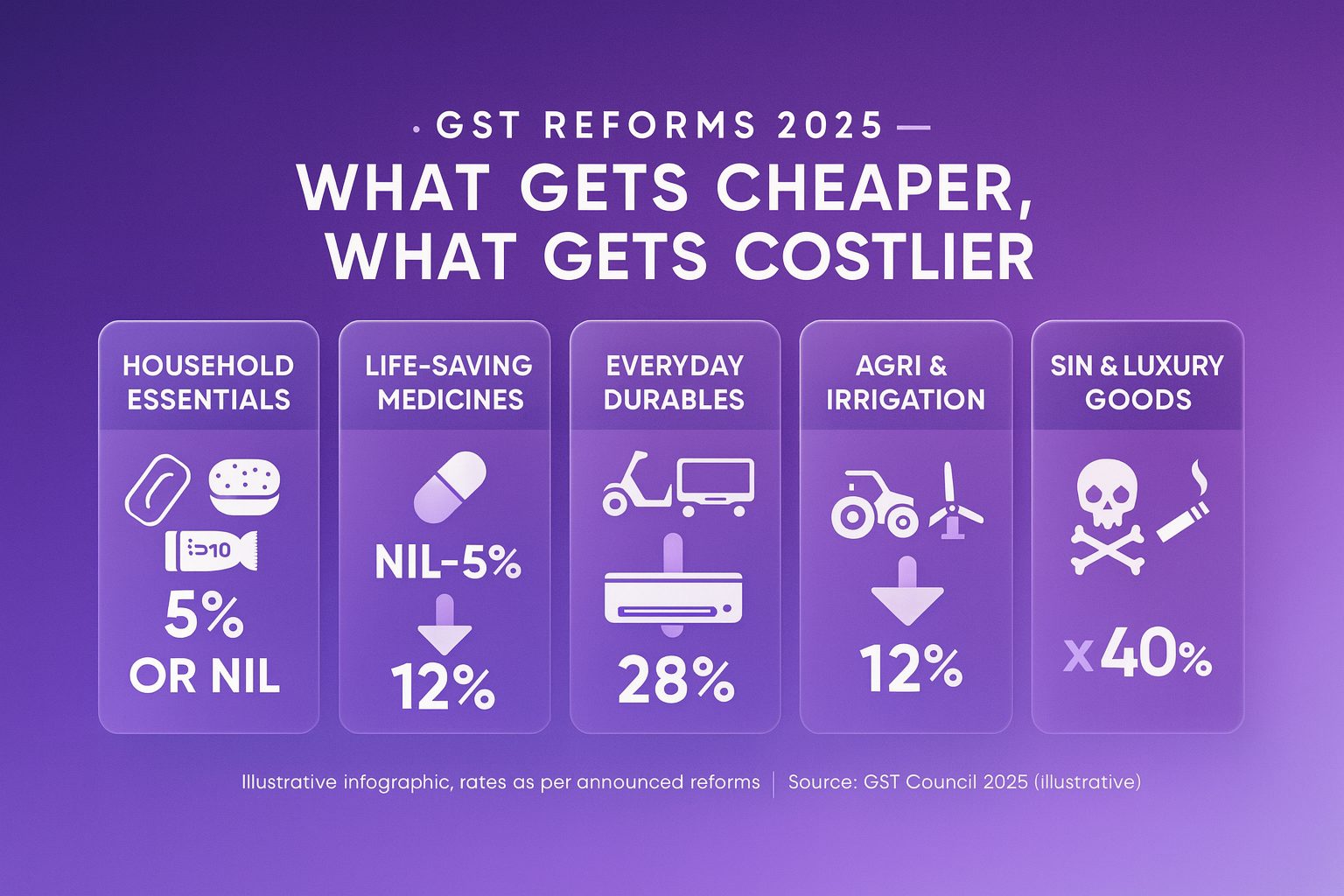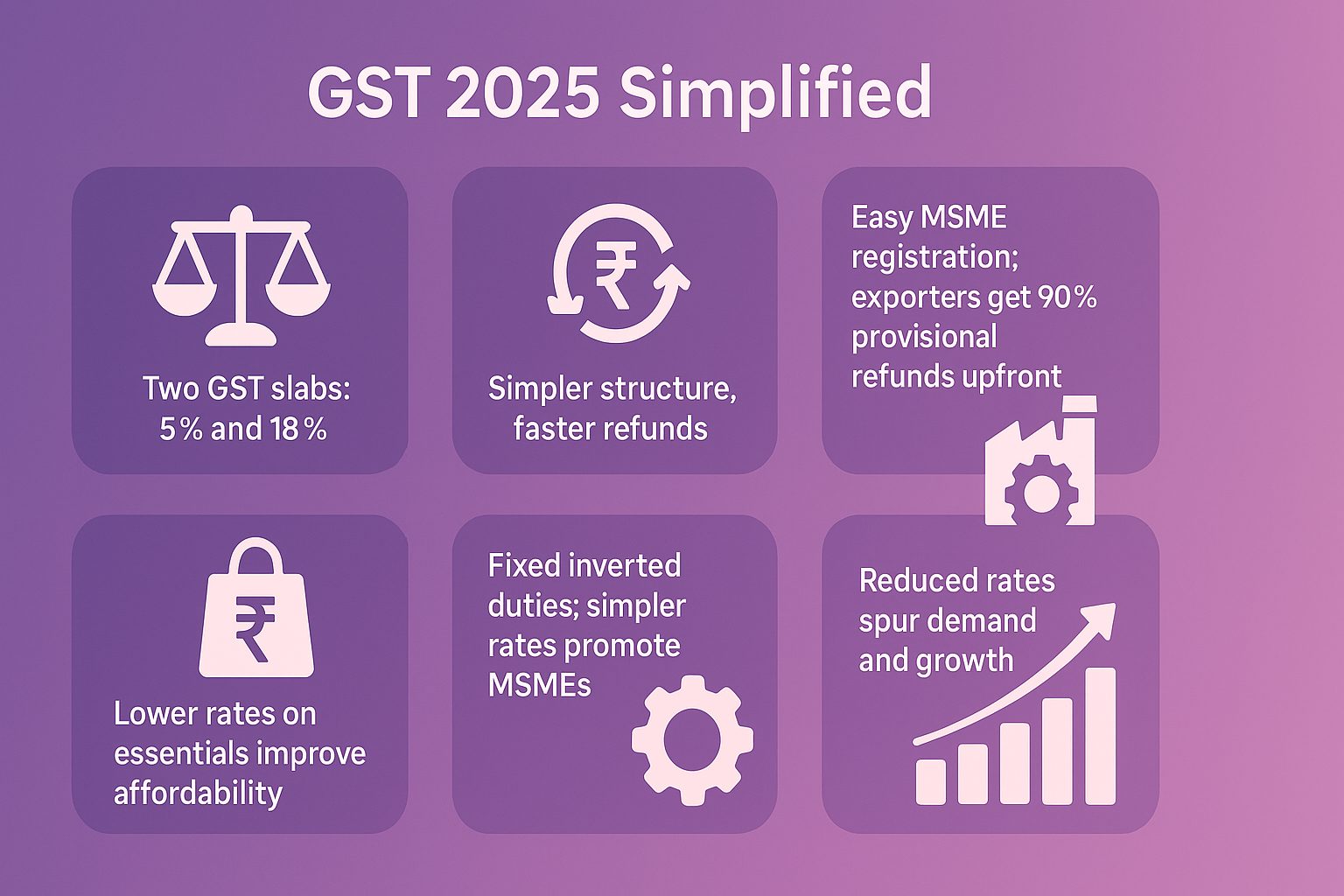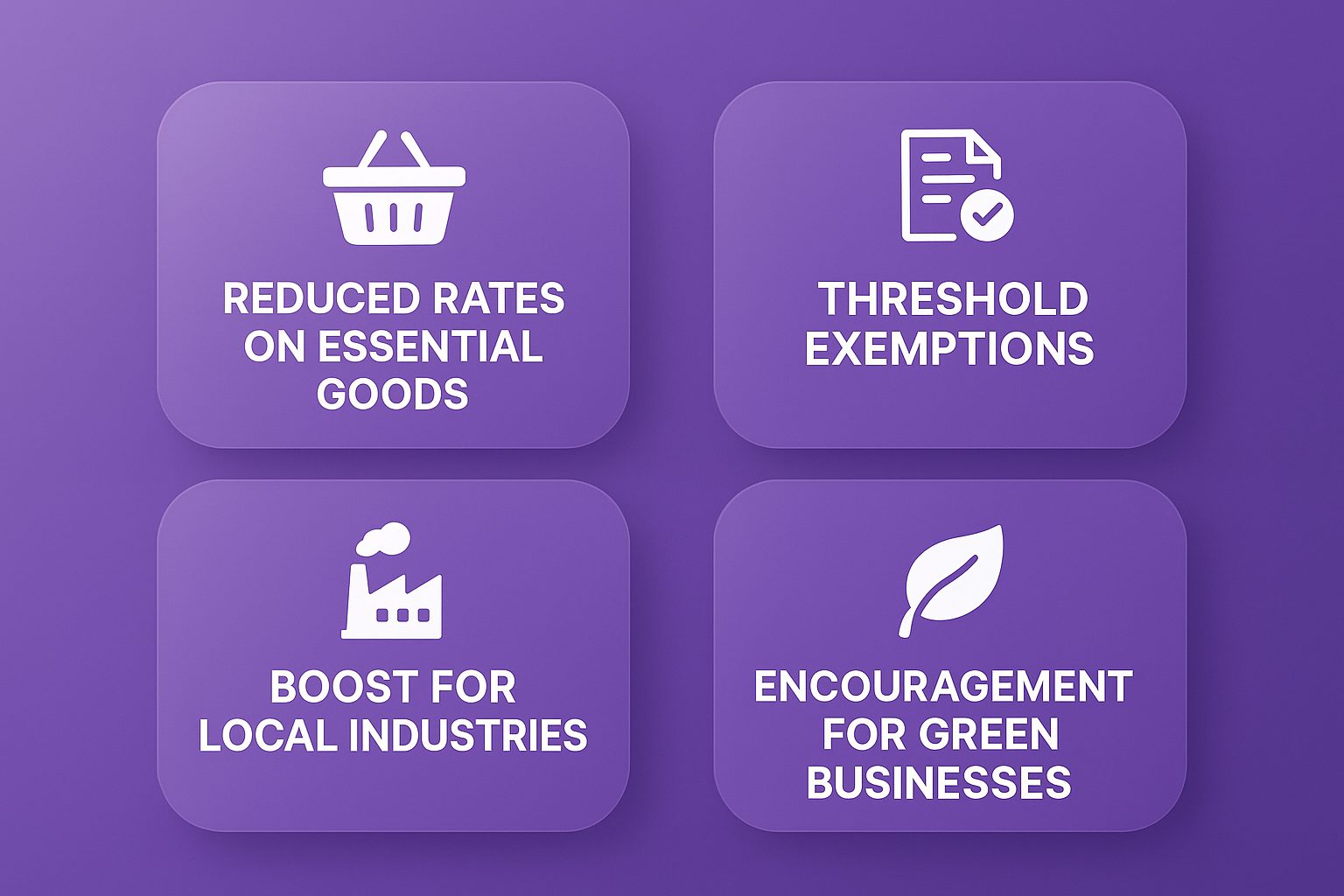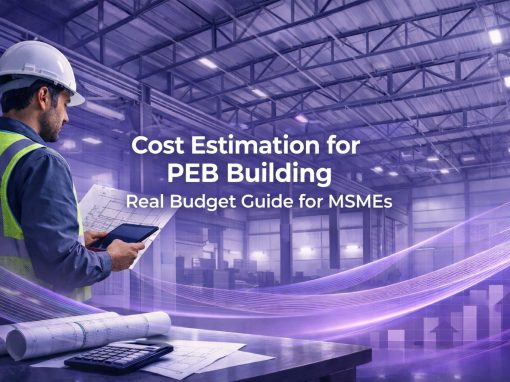Table of contents:
Overview of the New GST Rate List 2025
The new GST rate list for 2025 introduces significant updates aimed at simplifying compliance and boosting economic growth. GST, or Goods and Services Tax, is a comprehensive tax levied on the supply of goods and services. It replaced multiple indirect taxes in India and introduced a uniform tax structure.
The latest updates (as of August 2025) include revised GST rates across various categories. India is now moving to a simpler two-slab system with rates of 5% and 18%. At present, India’s GST is structured under four slabs – 5%, 12%, 18%, and 28%.
Key changes include reducing taxation on medical supplies from 12% to 5%, making healthcare more accessible. The proposed GST plan 2025 intends to make over 30 cancer and life-saving drugs tax-free.
The new GST plan 2025 also aims to reduce tax burden on entertainment, household appliances, renewable energy devices, daily food items, textiles and handicrafts, and agriculture equipment.
The proposal will be reviewed in the upcoming GST Council meeting.
Reference for previous GST rates: Takeaways from the 55th GST Council Meeting with Agenda Highlights
These changes are expected to impact businesses and consumers differently. For instance, a reduction in GST on certain raw materials will lower manufacturing costs. On the other hand, increased rates on non-essential services may positively affect consumer spending.
Sector-Specific GST Rates 
The latest 2025 GST rates provide clarity for various industries. Below are the revised rates for major sectors:
- GST reforms cut taxes on household essentials (soaps, toothpaste, Indian breads) to 5% or Nil
- Life-saving drugs, medicines reduced from 12% to Nil or 5%
- Two-wheelers, small cars, TVs, ACs, cement cut from 28% to 18%
- Farm machinery, irrigation equipment cut from 12% to 5%
- Tobacco, pan masala, aerated drinks, and luxury goods to be taxed at 40%
Comparison of New and Old GST Rates
The new GST rate list brings revisions aimed at balancing revenue with public welfare. Here’s a quick comparison:
| Items | Current GST Tax Rate (Until 21 Sep 2025) | New GST Tax Rate (From 22 Sep 2025) |
| Daily Essentials- Milk, Bread, Curd, etc. | Nil | Nil |
| Hair Oils, Shampoos, Toiletries, etc. | 18% | 5% |
| Butter, Ghee, and Cheese | 12% | 5% |
| Personal Health & Life Insurance | 18% | Nil |
| Air Conditioners | 28% | 18% |
| TVs & Refrigerators | 28% | 18% |
| Small Cars Below 1200cc | 28% | 18% |
| Bikes Below 350cc | 28% | 18% |
| Tableware, Kitchenware, Utensils & Bamboo Furniture | 12% | 5% |
| Stationery Items- Pencils, Charts, Globes, Exercise Books & Notebooks | 12% | 5% |
| Cement | 28% | 18% |
| Hotel Tariffs Up To ₹7500 | 12% | 5% |
| Agriculture Machinery- Tractors, Drip Irrigation Systems, Sprinklers, etc. | 12% | 5% |
| Aerated and Sugary Beverages, Caffeinated Beverages | 28% | 40% |
| Luxury Cars and Premium Bikes | 28% | 40% |
| Tobacco, Cigarettes, and Other Sin Goods | 28% | 40% |
These changes reflect the government’s effort to promote sustainable growth while maintaining fiscal discipline.
Analysis of Reasons Behind Rate Changes
- Encouraging Sustainability: Reductions in EV GST rates align with India’s push toward green energy and reducing carbon emissions.
- Boosting Healthcare Accessibility: Lower rates on medical devices aim to make critical healthcare affordable for the masses.
- Supporting Local Economies: GST exemptions for handicrafts promote small businesses and local artisans, preserving India’s cultural heritage.
- Economic Recovery Post-Pandemic: Reduced rates target essential and high-demand sectors to stimulate economic growth.
Top benefits of the new GST 2025 rates
- A simpler two-slab system of 5% and 18%.
- Smoother structures and faster refunds.
- Easy registration for MSMEs with 90% upfront provisional refunds for exporters.
- Lower GST rates on consumer items, boosting affordability.
- Fixed inverted duty structures and simpler rates to promote MSMEs.
- Reduced rates boost demand and growth.
Implications of Changes for Consumers and Businesses
For Consumers:
- Affordable electric vehicles encourage environmentally conscious purchases.
- A simplified 2-tier structure, fairer taxation, and digital filing for ease and faster refunds.
- Reduced costs for medical devices make treatments more accessible.
- Savings on handicrafts promote local, eco-friendly consumption.
For Businesses:
- Lowering rates on essentials and high-value items, empower MSMEs and manufacturers with smoother cash flows. It also strengthens state revenues and boosts demand, driving consumption and manufacturing growth across India.
- EV manufacturers can scale production with increased demand due to lower taxes.
- Handicraft businesses benefit from reduced compliance costs, allowing competitive pricing.
- Healthcare providers can lower prices, expanding their market reach.
Impact of GST Rate Changes on Small Businesses
The revised GST rates for 2025 bring both challenges and opportunities for small and medium enterprises (SMEs). These changes are designed to simplify compliance, encourage growth, and provide relief in critical sectors. However, adapting to the new framework requires careful planning and execution.
Challenges for SMEs with Revised GST Rates
- Increased Compliance Requirements:
SMEs must update their accounting and invoicing systems to align with the revised rates. For example, a small retail store may need to reprogram billing software to reflect the updated GST rates. - Cost Implications:
For sectors with higher GST rates on raw materials, production costs may rise. This can reduce profit margins for SMEs that operate on tight budgets. - Lack of Awareness:
Many small businesses, particularly in rural areas, lack access to clear and timely information about GST changes, leading to errors and penalties.
Opportunities and Benefits for Small Businesses
- Reduced Rates on Essential Goods
SMEs in sectors like healthcare or renewable energy benefit from lower GST rates. For instance, a solar panel manufacturer now enjoys reduced taxes, making their products more competitive. - Threshold Exemptions
Small businesses with turnovers below a specific limit are exempt from GST registration, reducing compliance burdens. - Boost for Local Industries
Handicraft and artisan businesses enjoy tax exemptions, allowing them to price their products more competitively. - Encouragement for Green Businesses
SMEs manufacturing electric vehicles or renewable energy products benefit from reduced GST rates, creating opportunities for growth in sustainable markets.
Case Studies/Examples Showing How Businesses Adapt to Rate Changes
- Case Study 1: A Handicraft Exporter
An SME specialising in handmade goods leveraged the GST rate to reduce costs. This enabled them to expand into new markets while maintaining competitive prices. - Case Study 2: An Electric Vehicle Startup
A small EV manufacturer utilised the reduced GST rate to offer discounts, boosting demand and market share. - Case Study 3: A Local Pharmacy
A neighbourhood pharmacy benefited from the reduced GST on medical devices and medicines, attracting more customers and improving profitability.
Tips for Compliance and Managing Tax Burdens Effectively
- Stay Updated:
Regularly monitor GST notifications through trusted sources like the GST portal or financial advisors. - Invest in Technology:
Use GST-compliant accounting software to automate invoicing and tax filing, reducing errors. - Leverage Tax Benefits:
Identify GST exemptions or reduced rates applicable to your sector and adjust pricing strategies accordingly. - Plan Cash Flow:
Account for possible delays in GST refunds and maintain a buffer for tax payments. - Seek Professional Advice:
Consult with tax advisors to ensure compliance and maximise benefits under the revised GST framework.
The new GST rates 2025 bring a mix of challenges and opportunities for SMEs. By staying informed and adopting proactive strategies, small businesses can not only comply with the updated framework, but also leverage it for sustainable growth.
How to Calculate GST Under the New Rates List
Understanding how to calculate GST is essential for businesses and consumers alike, especially with the updated GST rates for 2025. Proper calculation ensures compliance, accurate pricing, and transparent transactions.
Detailed Steps for Calculating GST
Follow these steps to calculate GST using the revised rates:
- Identify the Applicable GST Rate:
Determine the GST rate for the product or service (e.g., 5%, 12%, 18%). - Decide the Price Type:
Confirm whether the price is GST-inclusive or exclusive. - Apply the GST Formula:
- For GST-exclusive prices:
GST Amount = (Price × GST Rate) ÷ 100
Final Price = Price + GST Amount - For GST-inclusive prices:
Base Price = GST-inclusive Price ÷ (1 + GST Rate ÷ 100)
GST Amount = GST-inclusive Price − Base Price
- For GST-exclusive prices:
- Calculate Total Payable:
Add the GST amount to the base price if it’s exclusive.
Differences Between GST-Inclusive and Exclusive Prices
| Price Type | Explanation | Example |
| GST-Inclusive Price | The GST amount is already included in the displayed price. | A product priced at ₹118 (with 18% GST). |
| GST-Exclusive Price | The GST amount is calculated separately and added to the displayed price. | A product priced at ₹100 (plus 18% GST). |
Example for GST-Inclusive Price:
If the GST-inclusive price is ₹118 and the GST rate is 18%, the base price is:
Base Price = 118 ÷ (1 + 18 ÷ 100) = ₹100
GST Amount = 118 − 100 = ₹18
Example for GST-Exclusive Price:
If the base price is ₹100 and the GST rate is 18%, the GST amount is:
GST Amount = (100 × 18) ÷ 100 = ₹18
Final Price = 100 + 18 = ₹118
Practical Examples with Updated Rates
- Example 1: Electric Vehicles (5%)
Price (exclusive of GST): ₹1,00,000
GST Amount: (1,00,000 × 5) ÷ 100 = ₹5,000
Final Price: ₹1,00,000 + ₹5,000 = ₹1,05,000 - Example 2: Medical Devices (5%)
Price (exclusive of GST): ₹25,000
GST Amount: (25,000 × 5) ÷ 100 = ₹1,250
Final Price: ₹25,000 + ₹3,000 = ₹26,250 - Example 3: Luxury Goods (40%)
Price (exclusive of GST): ₹50,000
GST Amount: (50,000 × 40) ÷ 100 = ₹25,000
Final Price: ₹50,000 + ₹14,000 = ₹75,000
Online Tools and Calculators to Simplify the Process
- GST India Calculator:
A reliable tool for calculating GST-exclusive and inclusive prices with updated rates. - ClearTax GST Calculator:
An intuitive platform that supports advanced GST calculations, including reverse GST computation. - TaxAdda GST App:
A mobile-friendly app offering quick GST calculations on the go. - MyBillBook:
Combines invoicing and GST computation in a single interface.
These tools save time and ensure error-free calculations, making them invaluable for businesses and individuals managing GST compliance.
The Role of the GST Council and Future Predictions
The GST Council is pivotal in determining tax rates. In 2025, the council emphasized balancing revenue with economic growth. Key decisions included rate reductions for essential items and increased taxes on luxury goods.
Insights into the GST Council’s Role in Rate Revisions
The GST Rate List Identifies that GST Council operates as a collaborative platform where the Central and State governments make joint decisions on GST policies.
- Composition:
The Council comprises the Union Finance Minister, State Finance Ministers, and other representatives, ensuring balanced representation. - Objectives:
- Simplify GST structure to make compliance easier.
- Harmonize tax rates to reduce cascading effects.
- Adapt GST policies to address economic priorities, such as incentivizing green energy or boosting healthcare accessibility.
- Process:
The Council meets periodically to review GST collections, discuss industry feedback, and decide on rate adjustments. These deliberations are based on extensive data analysis and stakeholder consultations.
Key Decisions Taken for the 2025 GST Updates
The GST Council introduced several critical changes in 2025 to align with evolving market dynamics and public welfare needs:
- Reduced Rates on Essential Items:
- GST on medical devices reduced from 12% to 5% or NIL, prioritizing healthcare affordability.
- Electric vehicles taxed at 5%, supporting the green mobility agenda.
- Tax Exemptions:
- Handicrafts and similar goods exempted to promote small-scale industries.
- Rationalization of Rates:
- Luxury goods retained at higher slabs to discourage non-essential consumption.
- Services like tourism benefited from reduced rates to stimulate domestic travel.
Factors Influencing Future GST Rate List
- Economic Conditions:
Inflation rates, revenue collection goals, and GDP growth directly impact GST rate revisions. - Sectoral Priorities:
Sectors like renewable energy, healthcare, and education may see further rate reductions to align with government policies. - Global Trends:
International practices and trade policies influence India’s GST structure. For instance, lower rates on green technologies reflect a global shift toward sustainability. - Public Feedback:
Inputs from businesses, trade unions, and consumers help shape the GST Council’s decisions.
How Businesses Can Prepare for Upcoming Changes
- Stay Updated:
Regularly monitor GST notifications and Council meeting outcomes to anticipate rate changes. - Leverage Technology:
Adopt GST-compliant software to simplify rate updates and invoicing processes. - Consult Experts:
Engage tax professionals to analyse how potential changes could affect pricing, supply chains, and compliance. - Plan for Cash Flow Adjustments:
Prepare for temporary disruptions, such as delayed refunds or increased compliance costs, during policy transitions. - Focus on Sustainability:
Sectors aligned with government priorities, like green energy or small-scale industries, may benefit from future GST incentives. Businesses in these areas should capitalise on these opportunities.
Conclusion
The new GST rate list for 2025 reflects the GST Council’s commitment to fostering economic growth, promoting sustainability, and simplifying compliance. By introducing targeted rate reductions and exemptions, the Council has addressed critical sectors like healthcare, green mobility, and small-scale industries, making the GST framework more inclusive.
For businesses, adapting to these changes presents both challenges and opportunities. Staying informed about updates, leveraging technology for compliance, and aligning with government priorities are crucial for success. Consumers, too, benefit from reduced costs on essential goods and services, supporting broader economic welfare.
As GST evolves, its impact will continue to shape India’s economic landscape, providing a pathway for sustainable growth and fiscal efficiency. Whether you are a business owner or a consumer, understanding and adapting to these changes is key to thriving in the dynamic GST environment.
A product manager with a writer's heart, Anirban leverages his 6 years of experience to empower MSMEs in the business and technology sectors. His time at Tata nexarc honed his skills in crafting informative content tailored to MSME needs. Whether wielding words for business or developing innovative products for both Tata Nexarc and MSMEs, his passion for clear communication and a deep understanding of their challenges shine through.











